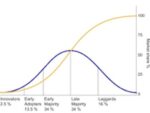You are currently viewing SemiWiki as a guest which gives you limited access to the site. To view blog comments and experience other SemiWiki features you must be a registered member. Registration is fast, simple, and absolutely free so please,
join our community today!
There is a lot being said about Intel getting the lead back from TSMC with their 18A process. Like anything else in the semiconductor industry there is much more here than meets the eye, absolutely.
From the surface, TSMC has a massive ecosystem and is in the lead as far as process technologies and foundry design starts but Intel is … Read More
If we look at the semiconductor industry expansion during the last 25 years, adoption of design IP in every application appears to be one of the major factors of success, with silicon technology incredible development by a x100 factor, from 250nm in 2018 to 3nm (if not 2nm) in 2023. We foresee the move to chiplet-based architecture… Read More
In the rapidly evolving landscape of artificial intelligence (AI) and data-intensive applications, the demand for high-performance interconnect technologies has never been more critical. Even the 100G Interconnect is already not fast enough for infrastructure applications. AI applications, with their massive datasets… Read More
While the leap from traditional SoC/IC designs to Three-Dimensional Integrated Circuits (3DICs) designs brings new benefits and opportunities, it also introduces new challenges. The benefits include performance, power efficiency, footprint reduction and cost savings. The challenges span design, verification, thermal… Read More
Dan is joined by Frank Schirrmeister. Frank is vice president of solutions and business development at Arteris. He leads activities for industry verticals, including automotive and enterprise computing and technology horizontals like artificial intelligence, machine learning, and safety. For DAC 2024, Frank is the vice… Read More
I confess I am reading tea leaves in this blog, but why not? Arm recently announced Arm Total Design, an expansion of their Compute Subsystems (CSS) offering which made me wonder about the motivation behind this direction. They have a lot of blue-chip partners lined up for this program yet only a general pointer to multi-die systems… Read More
Design re-use has enabled IC design teams to create billion-transistor designs where hundreds of IP blocks are pre-built from internal or external sources. Keeping track of where each of these IP blocks came from, what their version status is, managing IP, or even discerning their license status can be a full-time job if tracked… Read More
If you have anything to do with the semiconductor industry, you already know that one of the hottest areas for both manufacturing and EDA are systems designed with advanced packaging, basically putting more than one die (aka chiplets) in the same package.
When 3D packaging was first introduced, there were not really any effective… Read More
The world of computing is evolving rapidly, with a constant demand for more powerful and efficient systems. Generative AI has driven exponential growth in the amount of data that is generated and processed at very high data speeds and very low latencies. Traditionally, computing systems have been built using monolithic designs,… Read More
Much of the recent Keysight EDA 2024 announcement focuses on high-speed digital (HSD) and RF EDA features for Advanced Design System (ADS) and SystemVue users, including RF System Explorer, DPD Explorer (for digital pre-distortion), and design elements for 5G NTN, DVB-S2X, and satcom phased array applications. Two important… Read More










